9 Best AI Tools for Business Operations in 2025
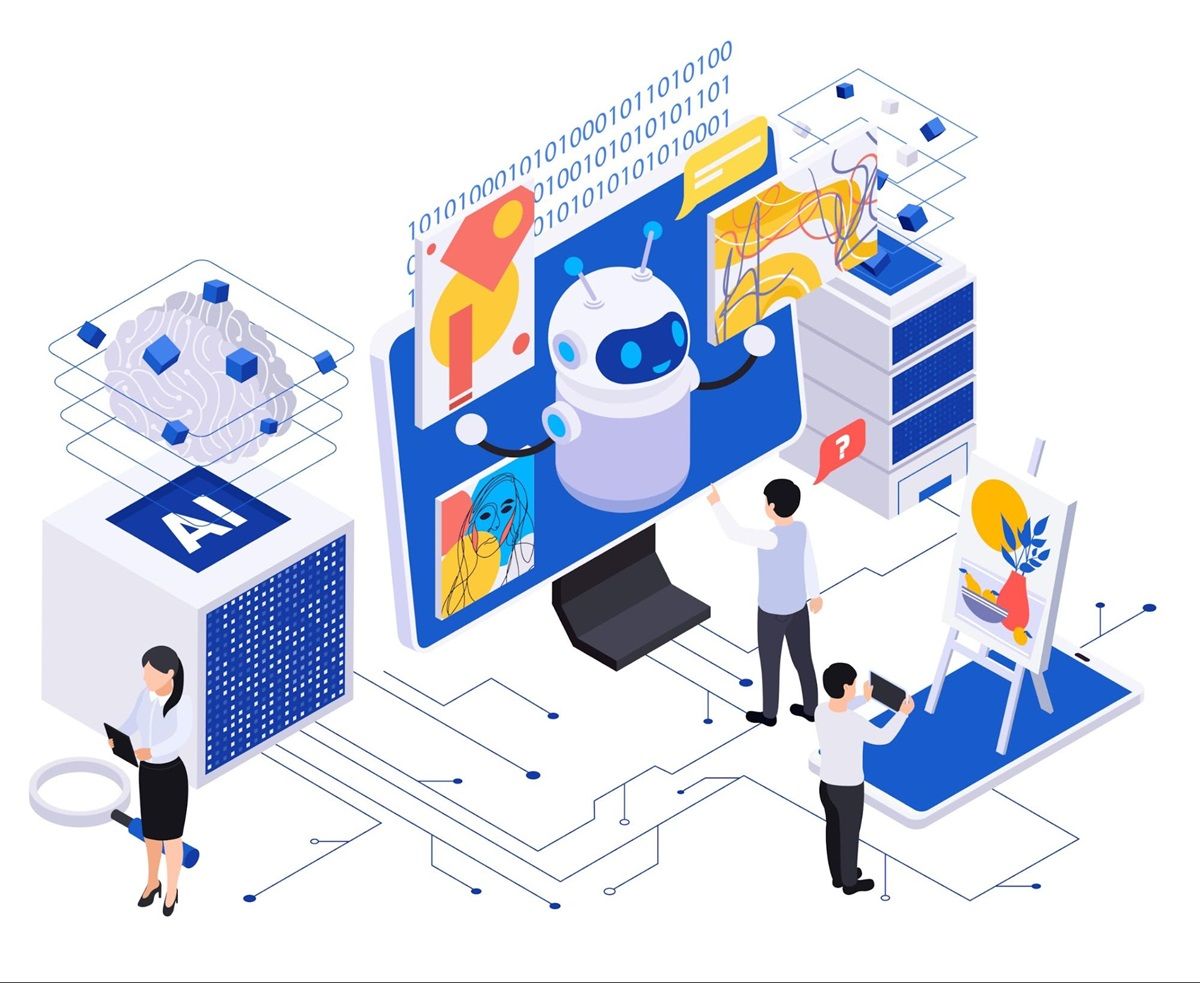
Tech giants aren't the only ones who use artificial intelligence anymore. Businesses of all sizes use AI to save time, cut costs, and make daily tasks easier.
From automation and data analysis to writing and image editing, the right apps handle work that used to take hours in just a few minutes.
These tools also improve business processes like hiring, reporting, or social media management, so you don't need to use a separate tool for every task.
In this guide, you'll see the best AI tools for different use cases. We'll cover AI productivity tools for automation, writing, visuals, design, and everyday business tasks.
Discover how much time you can save by signing up for free today!
How Do AI Productivity Tools Handle Business Operations?
AI tools play a direct role in business processes by taking over jobs that waste time.
Data entry, form processing, and invoice handling move faster when machines do it, and chatbots cover simple customer questions so your team can focus on harder work.
HR departments benefit too, since resume screening and interview scheduling no longer need hours of manual review.
Beyond workflow automation, these tools support data analysis on a level that people can't match alone. Predictive analytics comes out of machine learning and allows you to predict customer behavior or spot supply chain risks early.
Some platforms perform specific tasks using AI algorithms and present dashboards that simplify choices. An artificial intelligence technique called a neural network trains computers to analyze data in ways that highlight patterns people may overlook.
With an AI assistant, you can further draft notes, summarize meetings, or prepare content for marketing campaigns. Teams even measure public opinion with sentiment analysis on social media to see how people respond.
9 Best AI Tools for Business in 2025
The market is full of options, but only a few come out as the top AI tools that actually improve how work gets done. Each one tackles problems like repetitive tasks, slow decisions, or poor team coordination in a practical way.
Business Automation and Integrations
One tool stands out when it comes to business automation and integrations.
1. Activepieces
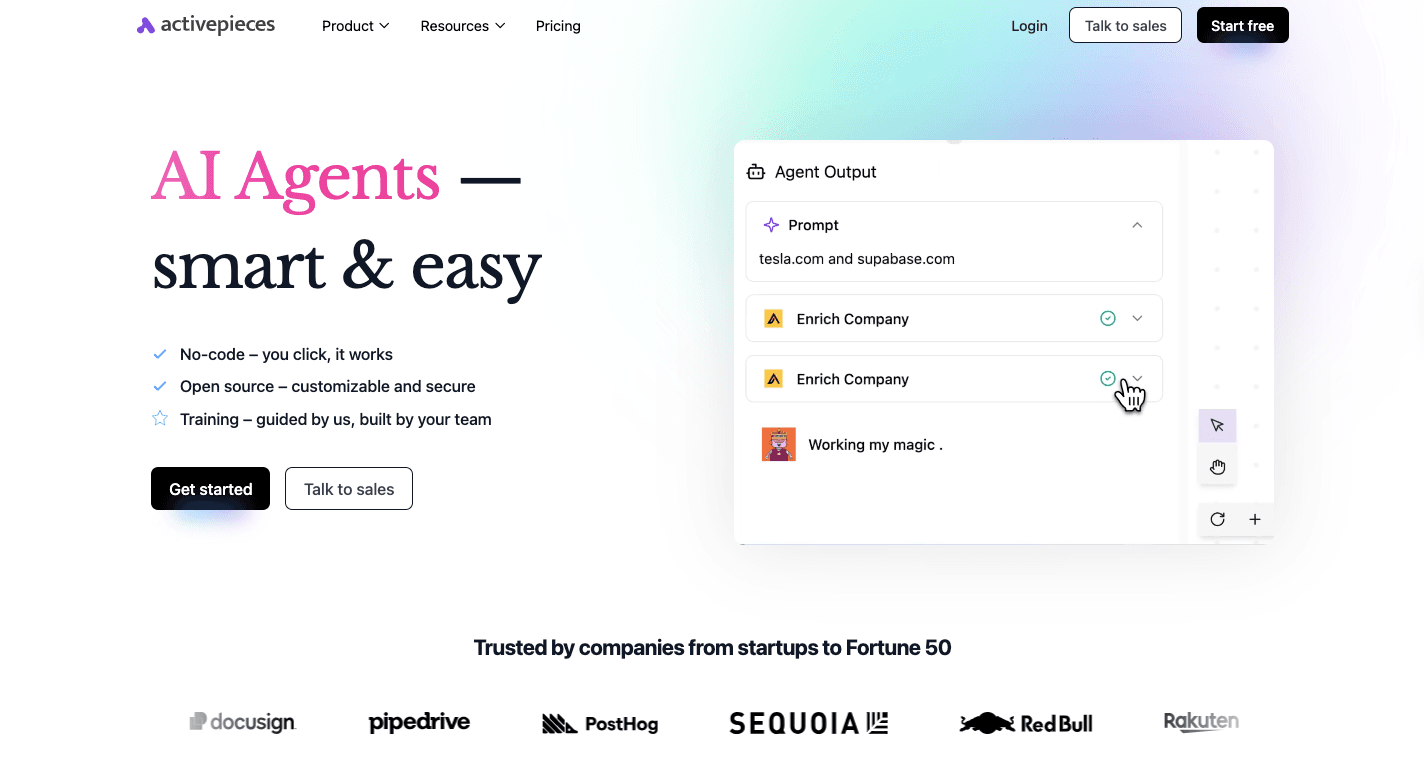
Activepieces is an AI-powered platform that makes automation for startups, individuals, and enterprises easier. Rather than spending time switching between apps, you can design workflows that connect other tools and automate tasks in minutes.
The visual builder is drag-and-drop, so anyone can create flows without needing to code. Each flow starts with a trigger, such as a new lead in a CRM or a new row in a spreadsheet, and then runs through actions such as sending an email, updating records, or posting a notification.
With built-in AI integration, you can enrich these workflows with text generation, analysis, or summaries at any step. Unlike many competitors, Activepieces supports self-hosting for full control and already includes over 427 pieces to connect apps and services.
It's made for all kinds of users: non-technical founders who need quick results, developers who want customizable automation, and enterprises looking for security and compliance.
Native support for AI agents makes it possible to run advanced workflows that combine triggers, logic, and AI assistance, creating a system that feels smarter the more you use it.
Key Features
- Visual workflow builder - Drag-and-drop builder to design automation flows without coding.
- Pre-built pieces - Over 427 integrations with apps across CRM, marketing, finance, and productivity.
- AI automation - Add steps that analyze, summarize, or generate content using AI models.
- Conditional logic - Use "if-else" branching, loops, and filters for complex workflows.
- Open source - Entire ecosystem is open, extensible, and community-driven.
- Self-hosting option - Run on your own server for maximum security and compliance.
- AI Copilot - An on-screen assistant that helps you design flows with suggestions.
- Human-in-loop steps - Add approvals or delays as part of any workflow.
- Custom code - Extend functionality using TypeScript for advanced needs.
- GitHub sync - Developers can build, test, and share custom integrations easily.
Integrations
At the most recent count, Activepieces offers 427 pre-built integrations, and the number continues to grow as the open-source community contributes new ones.
Unlike closed systems, Activepieces keeps expanding its library, ensuring it stays compatible with the tools businesses already rely on.
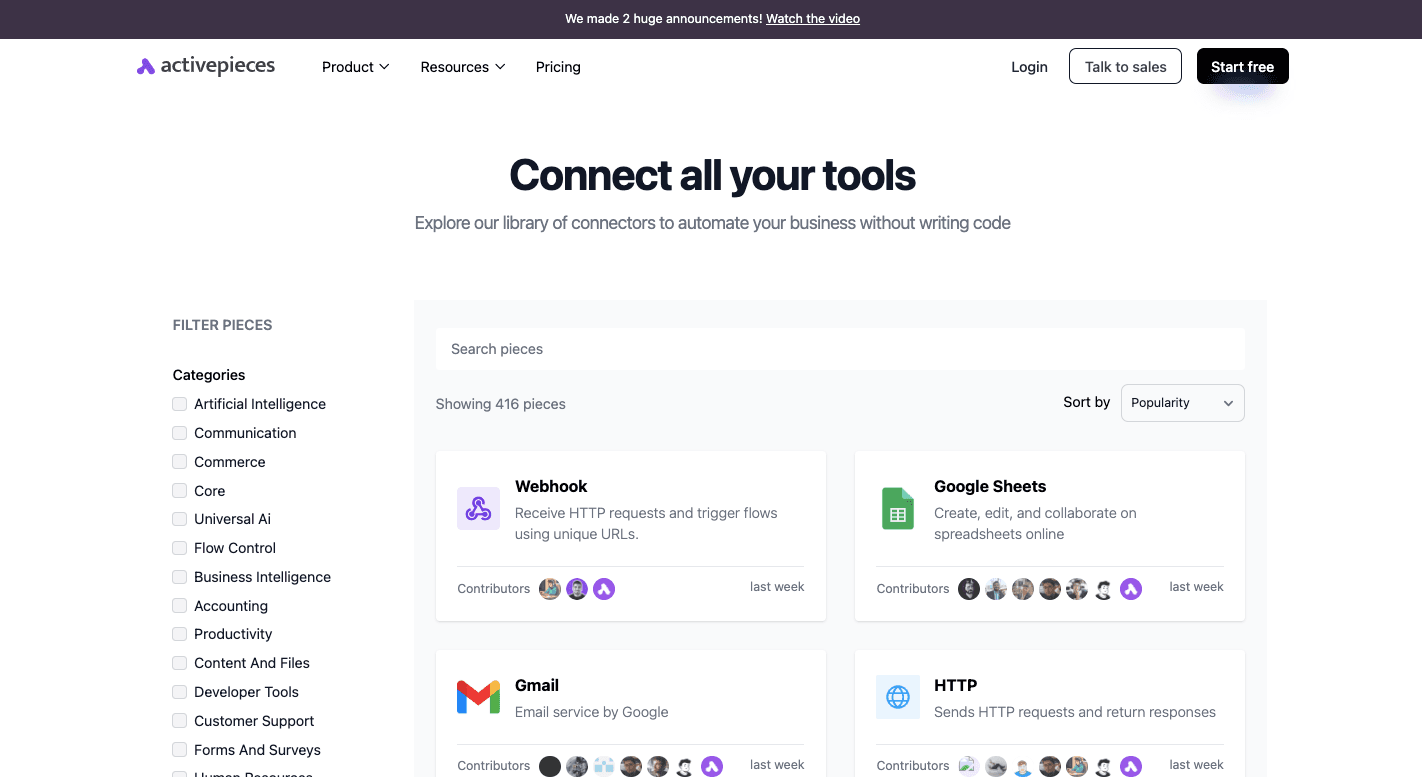
Highlights of its integration ecosystem include:
- OpenAI
- Google AI Studio (Gemini)
- ElevenLabs
- Google Sheets
- Microsoft Excel 365
- Slack
- Discord
- ClickUp
- Zoho Desk
- Microsoft Dynamics CRM
- HubSpot
- WordPress
- ActiveCampaign
- Microsoft Power BI
- Zoho Invoice
You can even create AI agents that interact with any of these services as part of a workflow. The combination of a generous free plan and enterprise-grade scalability makes it fit for individuals, startups, and large organizations alike.
Use Cases
The platform makes it simple to automate tasks across departments and turn manual processes into streamlined flows. Businesses can set up anything from sales to HR automations without heavy technical overhead.
Some practical examples from its use case library include:
- Lead appointment qualification - Make sure prospects are evaluated fairly and consistently, automatically routing them to the right sales reps.
- Lead nurturing - Deliver personalized articles, videos, or emails to leads over time to boost conversion chances.
- Coupon automation - Detect and mark coupons as used instantly, preventing fraud and reducing human error.
- Automated upselling - Spot the best opportunities to offer add-ons or upgrades at the right stage of a customer's journey.
- Expense tracker - Automatically capture, categorize, and record expenses, making financial operations smoother.
- CV screening and scoring - Streamline HR workflows by automatically reviewing resumes and highlighting top candidates.
These workflows illustrate how Activepieces goes beyond being an AI-powered platform and turns into a practical AI assistance layer for day-to-day operations.
Pricing
Activepieces offers both cloud-hosted and open-source versions. The Community Edition is free to self-host, with no task limits and full control of your data. You also get a generous free plan that includes a thousand tasks per month, AI credits, and two active flows.
The Plus plan costs $25 per month and provides unlimited tasks, more flows, AI credits, and email support. Then the Business plan is $150 per month and supports 50 flows, 1,000 AI credits, multiple projects, and team seats.
On custom pricing, the Enterprise plan provides you with advanced security, priority support, and tailored resources.
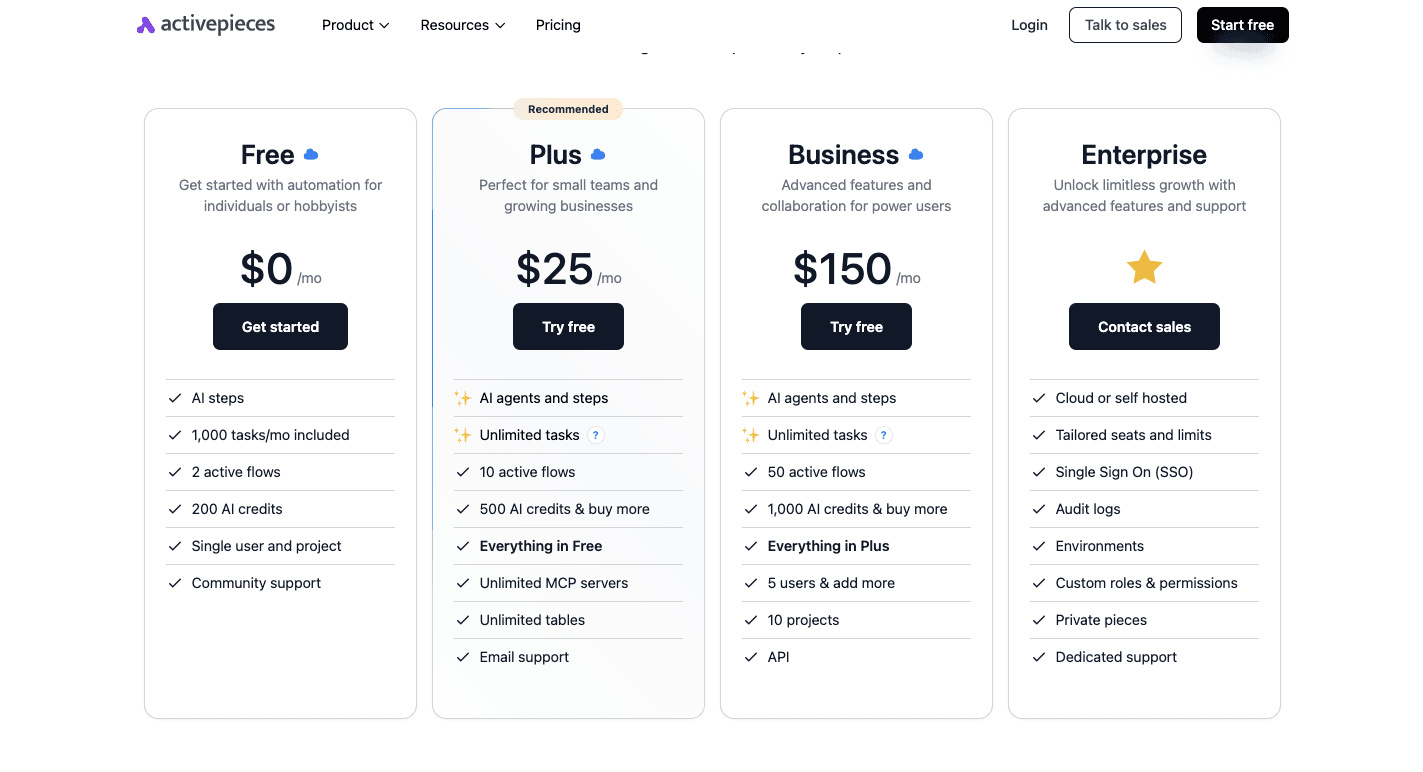
Compared to Zapier, Make, or n8n, Activepieces is more cost-effective because of flat-rate pricing and no hidden usage costs.
Schedule a call with sales and explore enterprise-ready automations!
Writing and Content Creation
Writing and content creation are everyday chores for many businesses. These tools can help:
2. Grammarly
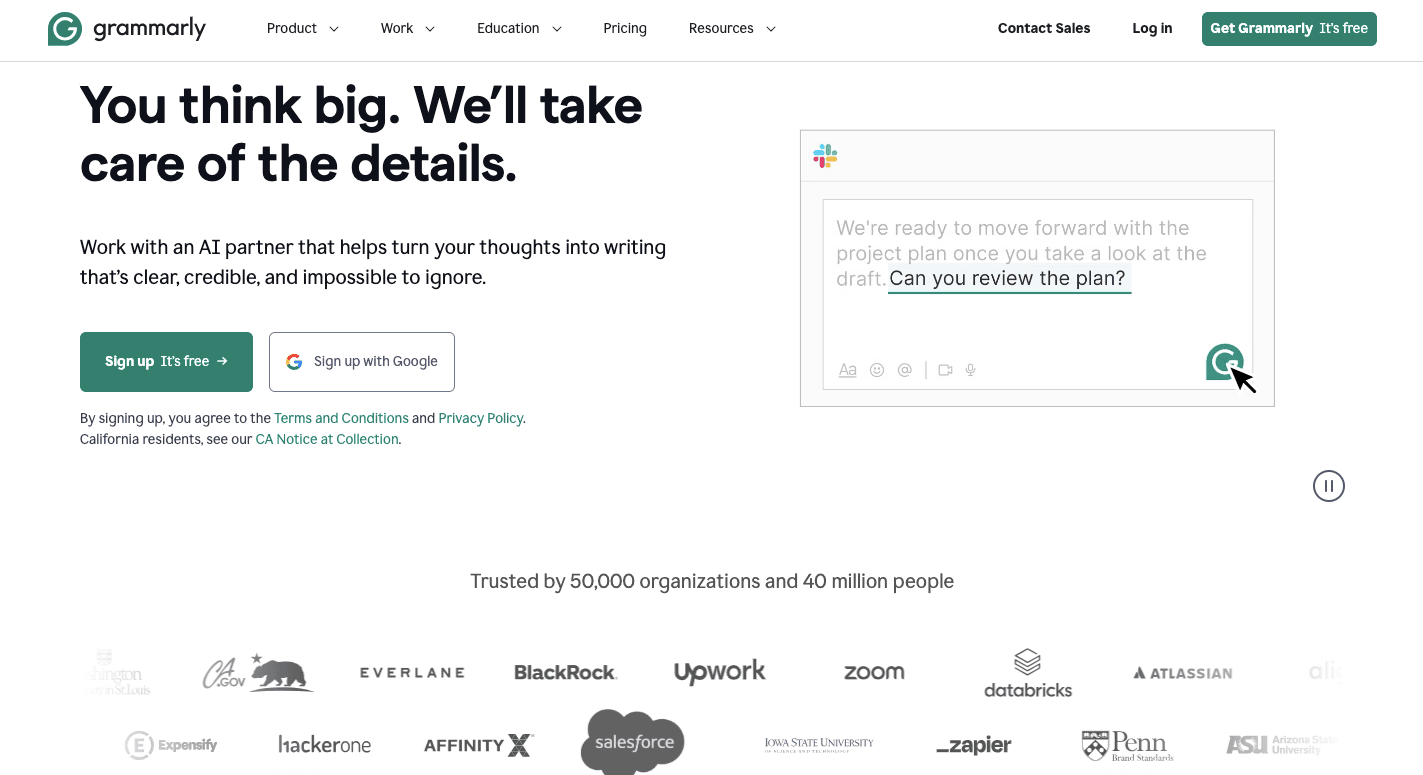
Grammarly is an AI tool for anyone who wants clear and direct writing. Many people rely on it to catch grammar and spelling errors, but it also helps with tone, style, and clarity.
You can use it almost anywhere you write: browser extension, desktop app, mobile keyboard, or web editor. It even integrates with Google Docs and Microsoft Word, which makes it convenient for school and professional work.
When you type, Grammarly checks your sentences and offers AI suggestions in a sidebar. Each tip comes with an explanation so you understand why the change matters.
Over time, the system adapts to your choices, so the support feels more personal. That makes the writing process easier and less stressful.
The free version goes further than a simple spellchecker. You also get tone detection and basic AI support. If you pay for the Pro or Business plan, you get features like plagiarism checks, rewrites, and team style guides.
Key Features
- Grammar and spelling checks - Spots typos and grammar mistakes in real time.
- Clarity and conciseness - Flags sentences that feel wordy and offers simpler options.
- Tone detection - Shows how your writing may sound, from formal to casual.
- Vocabulary suggestions - Suggests stronger word choices to avoid repetition.
- Plagiarism checker - Compares your work with billions of online sources.
- Generative AI (GrammarlyGO) - Writes drafts and rewrites text.
- Cross-platform access - Works across browsers, apps, and mobile devices.
- Personalized learning - Learns from your edits to give better feedback over time.
Pros
- Improves overall writing quality with real-time feedback.
- Saves time during editing and proofreading.
- Works across many platforms and apps.
- Includes plagiarism detection for paid plans.
Cons
- Premium features locked behind a paywall.
- Free users get frequent prompts to upgrade.
- Can misread tone or context in creative writing.
- Requires internet for most functions.
Pricing
Grammarly has a free version that covers grammar, spelling, and tone basics. Pro costs $30 per month per user and adds plagiarism checks, rewrites, and vocabulary tools.
Business and Enterprise plans build on that with custom style guides, admin roles, unlimited AI prompts, and dedicated support. These paid tiers are better suited for teams that need consistency across their writing.
3. Jasper AI
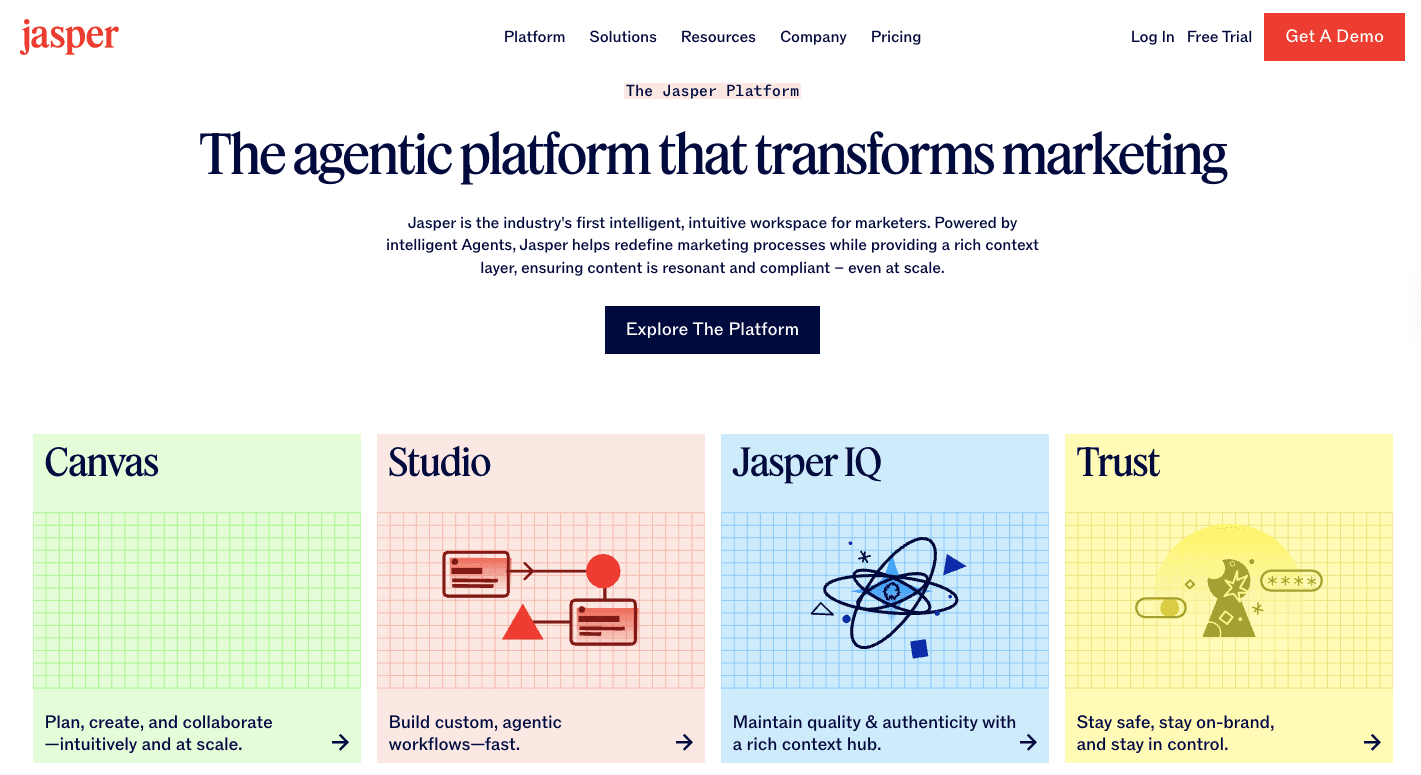
Jasper AI helps businesses and marketing teams create written content quickly and at scale. It belongs to the new class of generative platforms that can draft blog posts, social media posts, or email campaigns in seconds.
Once trained, it delivers text that sounds consistent with your company's style. Writers often find it easier to keep tone and accuracy aligned when the system is tuned to their knowledge base.
To create content, you enter a prompt, and the system generates high-quality text with minimal input. It can produce anything from a short caption to a long article.
You can choose from a library of templates, too, so it'll be easier to do landing pages, Google Ads copy, or product descriptions. Jasper isn't limited to written text, either. The platform can also draft video scripts for tutorials, ads, or training content.
Some often use it for content marketing and larger marketing campaigns, since it saves time without sacrificing quality. By combining user prompts with its brand voice and knowledge features, Jasper makes it easier to keep all content consistent across channels.
Key Features
- Brand voice - Trains the AI to match your company's tone and style for consistent output.
- Jasper chat - A conversational tool for brainstorming and quick drafting with access to your brand data.
- Templates and workflows - Includes over 50 templates for common needs like blog posts, ad copy, or video scripts.
- Content Lookback - Maintains context across longer pieces so the text stays coherent.
- SEO integration - Works with Surfer SEO to help optimize articles for search engine visibility.
- Visual content - Jasper Art creates original AI image outputs from text prompts.
- Plagiarism checker - Helps confirm the originality of generated content.
- Multilingual support - Writes in more than 30 languages.
- Collaboration - Teams can share and edit drafts together on higher-tier plans.
- Browser extension - Brings Jasper into tools like Gmail, WordPress, and Google Docs.
Pros
- Wide range of templates for blogs, social media posts, video scripts, and ads.
- Produces content quickly for tight deadlines.
- "Brand Voice" ensures consistency across all channels.
- Supports search engine optimization during writing.
Cons
- Needs fact-checking to confirm accuracy.
- May oversimplify technical or complex topics.
- Output can sound repetitive with weak prompts.
- Quality depends heavily on prompt detail.
Pricing
Jasper offers two main plans. The Pro plan costs $69 per seat each month and includes one user seat, access to the content canvas, brand voice settings, and five knowledge assets. It also supports three target audiences for tailored writing.
The Business plan has custom pricing and adds advanced apps for complex marketing campaigns, an AI app builder, unlimited customization of brand voices and knowledge assets, and enterprise-level admin controls.
API access and priority support are also part of the package.
4. Perplexity
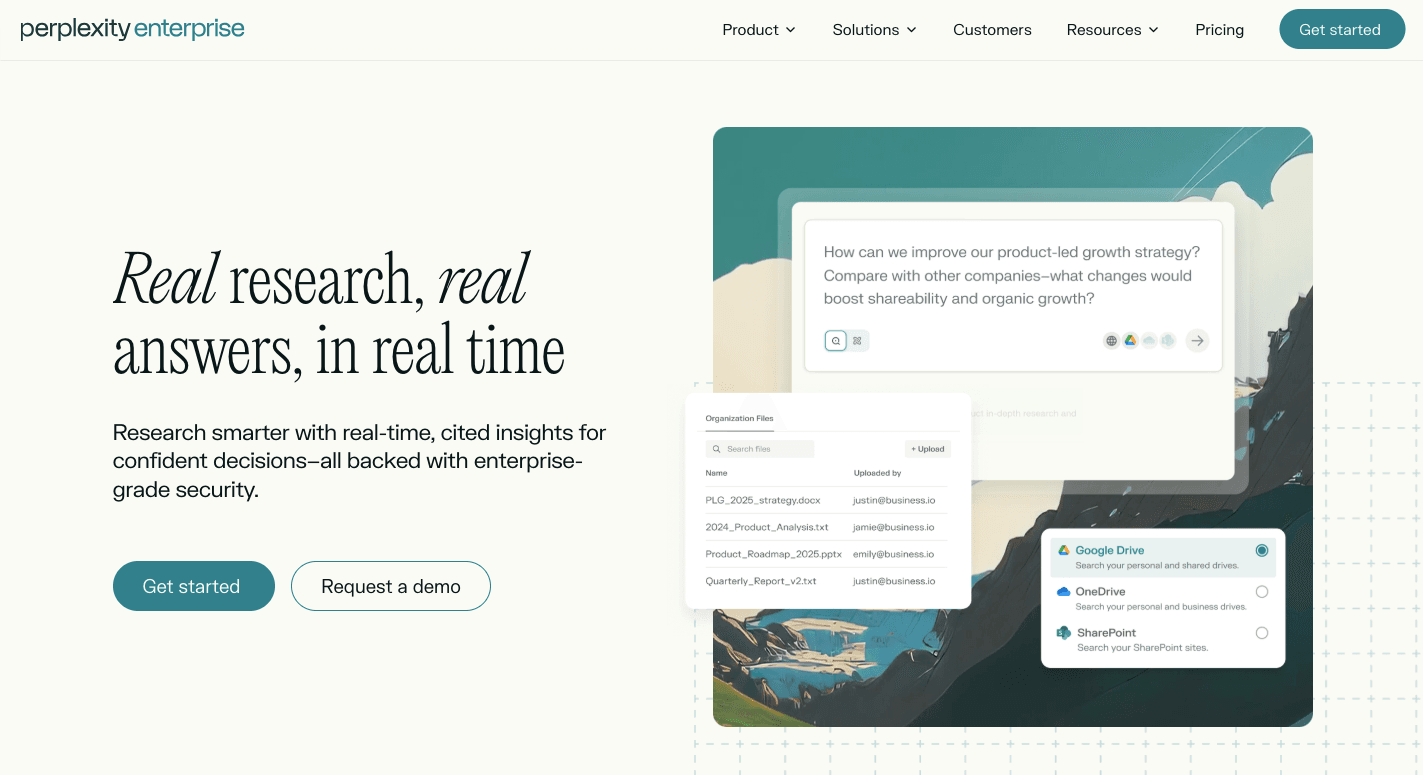
Perplexity is an AI-powered answer engine that functions like a research assistant. Unlike a standard Google search, which gives you a list of links, Perplexity generates direct summaries with citations so you can verify the source.
That means you save time and avoid scanning through endless web pages to find the details you need. Many people use it to gather information for reports, blog posts, or presentations, since it speeds up research-heavy work.
The system uses natural language processing to understand questions the way you would ask them in conversation. It can handle multi-step queries, pull live information from the web, and return well-organized answers.
Since it operates similarly to chat-based AI models, it adds real-time search to make sure the information is current.
Every answer comes with citations, so fact-checking is simple. You can also use collaborative spaces to organize research.
Key Features
- Conversational search - Uses natural language processing to understand complex questions.
- Cited answers - Provides clickable references for every claim.
- Deep Research - Runs advanced searches and compiles findings into detailed reports.
- Focus modes - Let users refine results by type, such as news, social, or academic.
- Collections - Organizes related queries into shareable folders for projects.
- Perplexity Pages - Turns search results into polished, shareable articles.
- File analysis - Upload documents and have the AI summarize their content.
- Image and video generation - Creates media from prompts on higher-tier plans.
- Collaboration - Shared workspaces for teams to manage ongoing research.
- Multiple model access - Lets Pro users choose from different AI models like GPT and Claude.
- Integrations - Connects with tools like Google Drive and Slack to extend workflows.
Pros
- Saves time on research with clear summaries.
- Real-time data instead of static knowledge.
- Offers free access with generous limits.
- Supports file uploads for extra context.
Cons
- May produce incorrect or misleading responses.
- Context can break down during long chats.
- Relies on third-party models and data sources.
- Security and privacy concerns for sensitive data.
Pricing
Perplexity has several tiers. The free Standard plan offers unlimited quick searches with limited Pro searches and follow-up questions.
For $20 per month, the Pro plan removes caps on Pro searches, adds access to premium AI models, and supports unlimited file uploads, along with video and image generation.
Larger teams usually prefer the Enterprise Pro at $40 per seat per month, which adds internal knowledge search, advanced privacy settings, and team management controls.
The Enterprise Max tier costs $325 per user each month and includes expanded storage, advanced models, video generation, and full integration with services like Google Drive, SharePoint, and Box.
Visual Content and Creativity
The following tools can help your business with visual content.
5. Midjourney
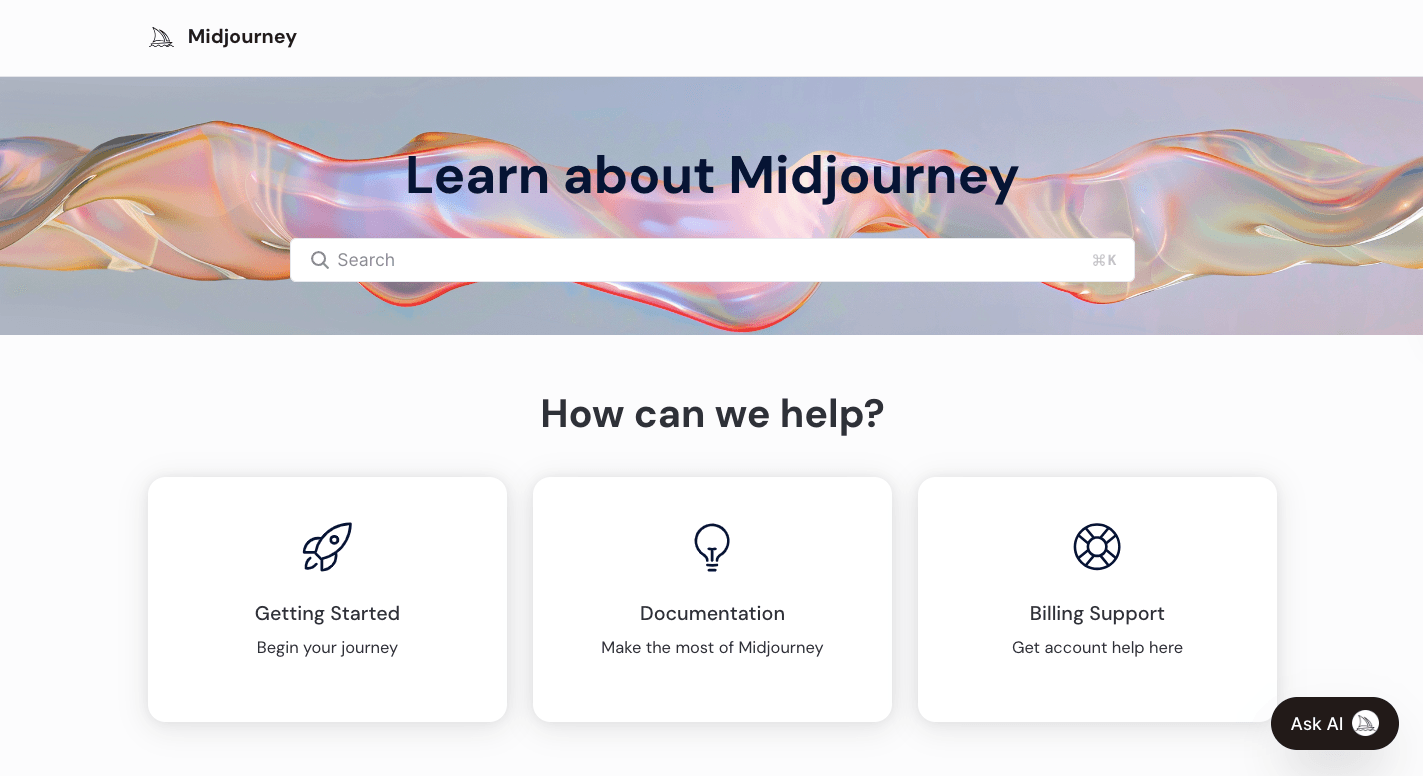
Midjourney focuses on AI image generation. Many creative professionals use it to produce concept art, mockups, or marketing visuals in styles ranging from photo-realistic to highly artistic.
The system works through prompts that describe the image you want. It then uses advanced diffusion models to transform noise into detailed images. You usually receive four options within a minute, which you can refine by choosing new variations or upscaling to a higher resolution.
Originally, Midjourney operated mainly on Discord. While a web interface is now available, the Discord option remains favored because it fosters an active community where people share prompts and results.
That community is also a great learning resource. Midjourney gives plenty of control with parameters for size, style, and detail. It can even reference previous images to maintain character consistency or expand an existing scene.
For businesses, the ability to generate visuals that align with whatever brand guidelines you have can be a time-saver. Although it doesn't always offer perfect precision, its output is often amazing and polished.
Key Features
- Prompt-based generation - Create visuals by typing detailed text descriptions.
- Artistic style - Produces painterly, cinematic, or abstract looks by default.
- High-quality results - Generates sharp, detailed, and unique visuals.
- Aspect ratio control - Adjust image proportions with the "--ar parameter."
- Style reference - Borrow the look of another image to guide the output.
- Character reference - Keep character details consistent across multiple images.
- Negative prompting - Remove elements you don't want in the final result.
- Image weight - Balance how much an image input influences the output.
- Upscaling - Enlarge chosen results for higher resolution.
- Variation tools - Generate new sets of images based on one option.
- Community and gallery - Access shared prompts and results for ideas.
- Web editor - Offers direct editing for more detailed control.
Pros
- Produces highly artistic and creative visuals.
- Wide range of customization controls.
- Frequent updates improve output quality.
- Advanced web editing features.
Cons
- Precision control is limited compared to design software.
- Often struggles with generating readable text in images.
- Occasional inconsistencies in anatomy or fine details.
- No free plan or trial option available.
Pricing
Midjourney has four paid subscription levels. The Basic plan costs $10 per month and includes 3.3 hours of Fast GPU time, while the Standard plan at $30 per month provides 15 hours plus unlimited Relax mode generations.
On the other hand, the Pro plan is $60 per month and offers 30 hours, unlimited Relax mode, and private Stealth mode. The highest option, the Mega plan, costs $120 per month and includes 60 Fast hours, unlimited Relax mode, and Stealth mode.
6. Descript
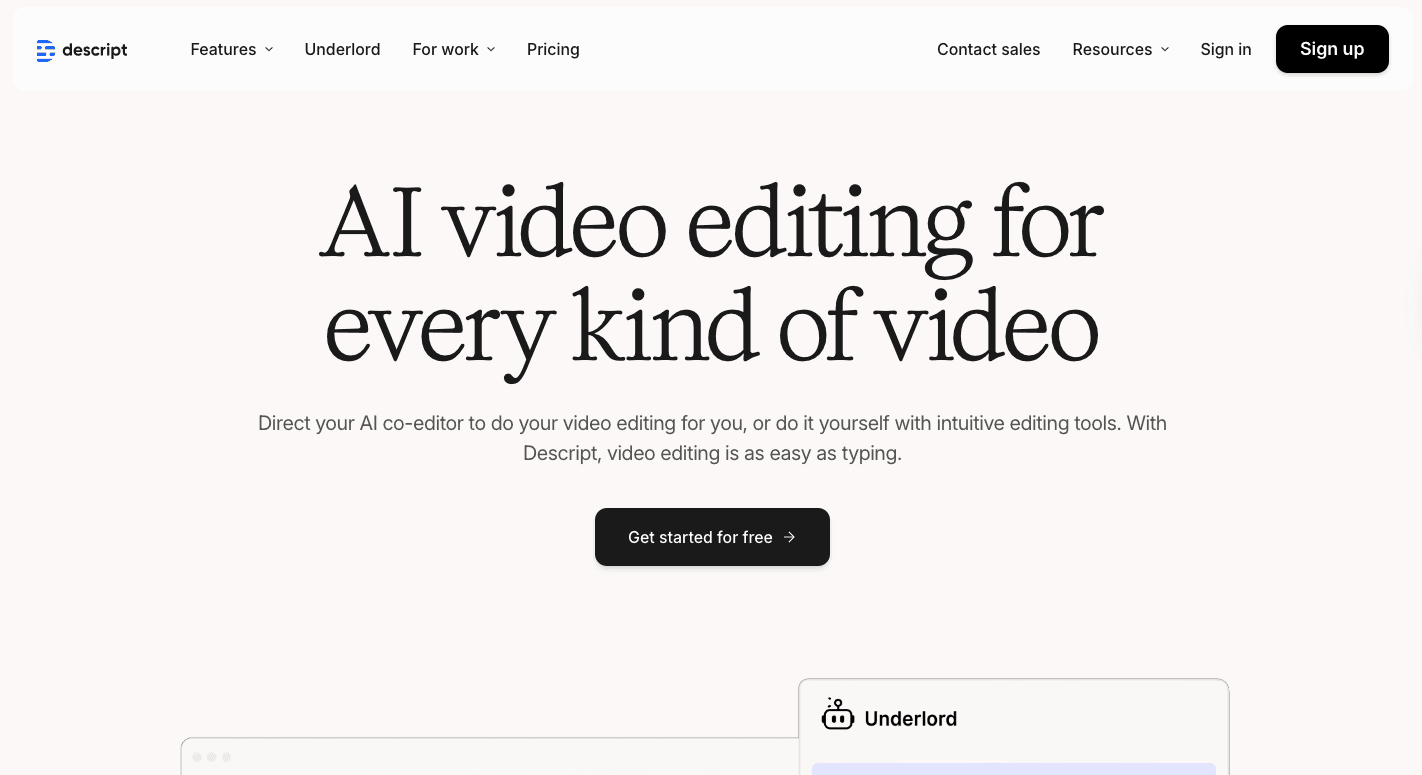
Descript helps creators move faster by turning media edits into simple text changes. You import a file or record inside the app, and the tool transcribes speech so you can cut, copy, and rearrange by editing words on a page.
Many teams pick it for video editing. You can clean up audio, trim pauses, and remove filler words in a few clicks. Studio Sound boosts voice clarity, while "Eye Contact" keeps on-camera delivery steady.
Overdub lets you fix a misspoken line by typing new words, which saves another take. The video creation process also benefits from screen recording, stock inserts, and automatic captions for social clips.
Need a quick soundtrack? Add background music from the built-in library and balance levels with simple sliders. When the edit looks right, publish a share link, export the file, or send straight to platforms.
From inside the app, you can post directly to a YouTube video. You can run Descript on a desktop or in a browser, keep projects synced in the cloud, and invite teammates to comment and edit in real time.
Key Features
- Text-based editing - Edit audio and video by changing the transcript line.
- Automatic transcription - Generate synced text that drives every cut.
- Filler word removal - Delete "ums" and "uhs" across a project in seconds.
- Studio sound - Reduce noise and echo for cleaner voices.
- Overdub voice - Type a fix and replace the spoken line with your clone.
- AI eye contact - Adjust gaze so presenters look into the camera.
- Green screen - Replace or blur backgrounds without special gear.
- Canvas layout - Arrange titles, images, and B-roll on a visual stage.
- Multitrack timeline - Fine-tune timing after the transcript pass.
- Screen and webcam recorders - Capture tutorials and explainers in a single place.
- Caption engine - Auto-create styled subtitles for social exports.
- Stock media and music - Drop clips and background music from built-ins.
- Direct publish - Export files or send to a YouTube video channel.
- Team collaboration - Share projects, comments, and versions together.
Pros
- Edit by text, which saves hours on cuts.
- Fix lines with Overdub instead of re-recording.
- Solid tools for social repurposing and captions.
- Cloud projects with real-time collaboration.
Cons
- Learning curve for users used to classic timelines.
- Not recommended for heavy VFX or color grading.
- Large projects can slow down on modest hardware.
- Internet connection is required for many AI features.
Pricing
Descript offers a free plan with one hour of transcription each month, 720p exports with a watermark, unlimited projects, and a limited trial of core AI tools. The Hobbyist plan runs $24 per user monthly with 10 hours of transcription and 1080p exports without a watermark.
Creator costs $35 per user monthly and adds 30 hours of transcription, 4K export, broader AI features, and stock media access. The Business plan is $65 per user monthly with 40 hours of transcription, advanced collaboration, and priority support.
Enterprise uses custom pricing and includes unlimited transcription, SSO, deeper security controls, and a dedicated account representative.
7. Runway
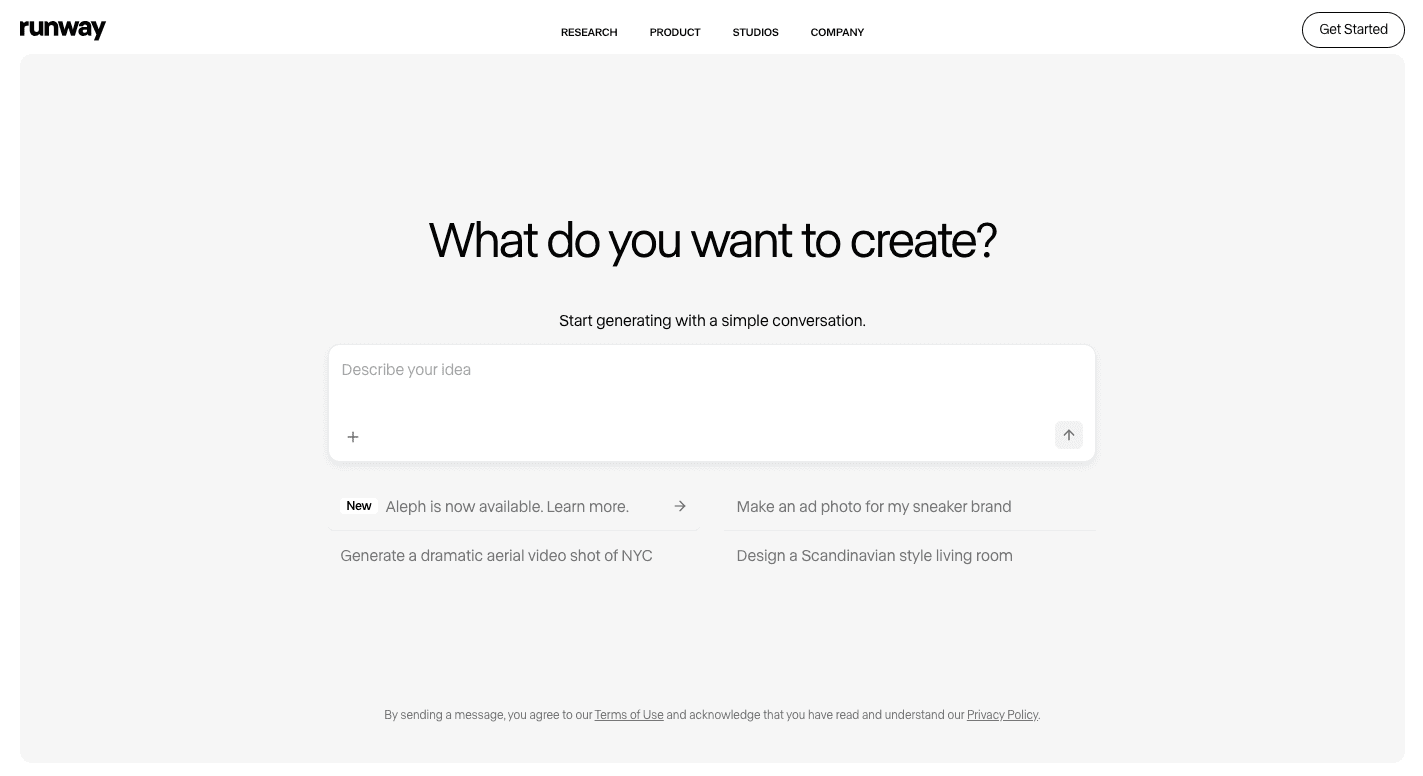
Runway is for creators who want an AI video platform without dealing with heavy software setups. Everything runs in the cloud, so you can work from a laptop without needing high-end hardware.
The system's models interpret prompts to create visuals that match your description. Be it a short cinematic sequence or a stylized animation. You can refine outputs by reusing frames, adjusting styles, or layering effects until the sequence feels complete.
There's an editing hub that lets you erase unwanted objects, change backgrounds, or slow down footage. Motion tracking and color grading tools make it possible to fine-tune results in ways that normally require advanced editors.
Beyond creation and editing, many teams use Runway to produce social media marketing videos in minutes. Music libraries and audio cleanup help polish the final cut, while direct export options get projects online quickly.
Key Features
- Text-to-video - Create video clips from written prompts.
- Image-to-video - Animate static photos with motion.
- Video-to-video - Restyle or alter an uploaded clip.
- Gen-4 model - The most advanced model for realistic and cinematic outputs.
- Motion brush - Apply motion to selected areas of an image.
- Inpainting - Erase unwanted elements and regenerate missing parts.
- Background removal - Swap out or delete backdrops without a green screen.
- Scene detection - Auto-cut clips into segments for easier editing.
- Super slow motion - Generate smooth slow-motion effects.
- Upscaling - Export videos in higher resolution, up to 4K.
- Expand video - Adjust aspect ratios by filling in missing edges.
- AI image tools - Generate, edit, and expand pictures using prompts.
- Audio tools - Generate voices, sync lip movement, and clean up sound.
Pros
- Accessible for non-technical users.
- Frequent model updates improve visual quality.
- Cloud-based access without heavy hardware.
- Real-time collaboration across teams.
Cons
- Advanced tools have a steep learning curve.
- Outputs may vary in quality with complex prompts.
- Dependence on the internet connection.
- Occasional bugs or crashes with longer projects.
Pricing
Runway has several subscription options. The free plan gives 125 credits, enough for a few images or short clips, but results are watermarked and slow to process. At $15 per month, the Standard plan provides 625 credits, watermark-free exports, and 100 GB of storage.
The Pro plan is $35 per month with 2,250 credits, 500 GB of storage, and advanced tools like custom voices. Then the Unlimited plan is $95 per month, offering relaxed-rate usage of models and extra generation capacity.
For larger companies, t_he Enterprise plan is custom-priced_ and includes higher storage, team management, and priority support.
Design and Product Development
The following AI tools can help you design and develop products.
8. Lovable
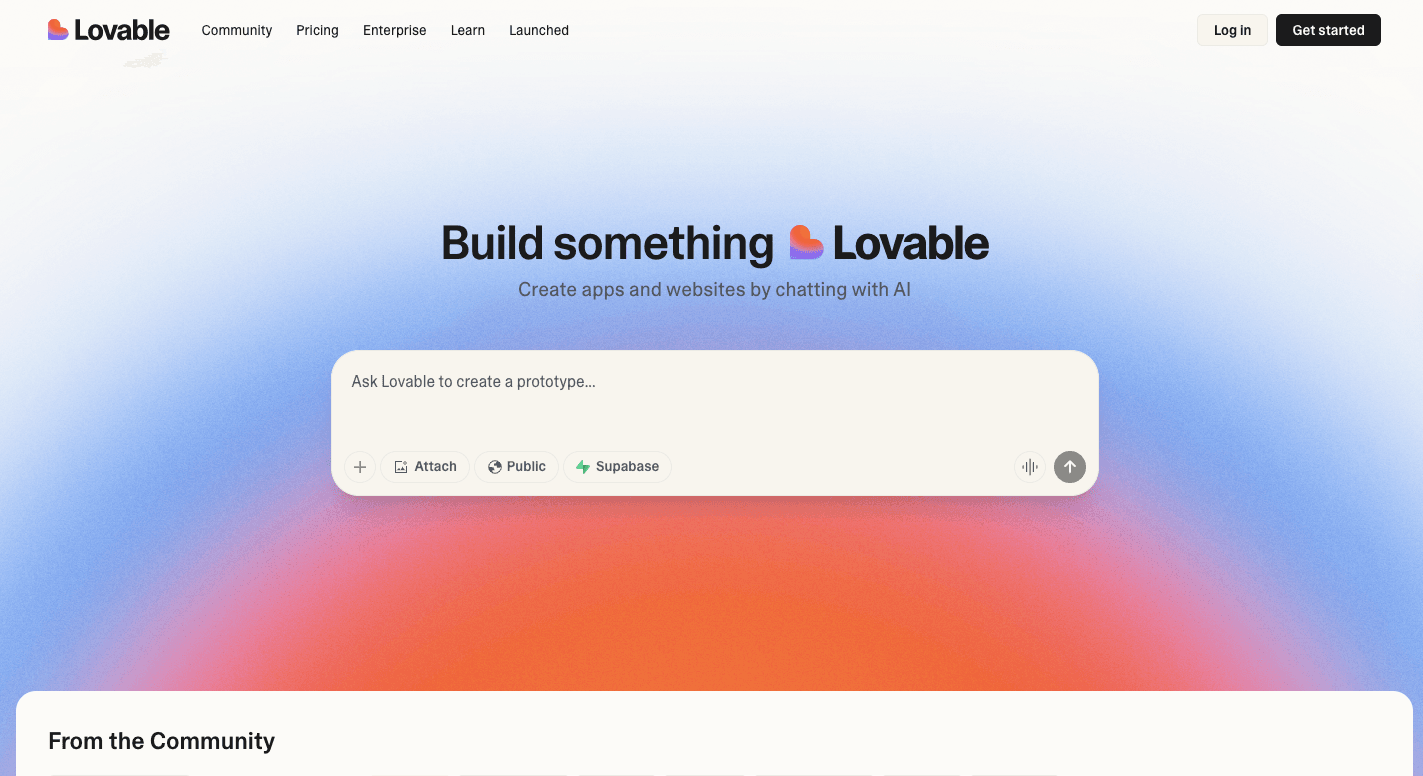
Lovable, once called a GPT Engineer, makes app creation simpler by letting you describe your idea in plain words. You start a chat with the system, explain the kind of app you want, and it builds the front end and back end automatically.
A live preview shows the app as it takes shape, so you can ask for changes and see results right away. Designers can upload screenshots or Figma files, while founders without coding skills can type prompts to get a working product.
Developers also benefit because it skips the setup work and produces ready-to-edit code that can sync with GitHub.
It further supports modern frameworks for visuals and integrates with Supabase to handle databases, authentication, and APIs. For non-technical users, it removes the barrier of writing code by hand.
Engineers, on the other hand, use it to accelerate prototyping and allow deeper customization.
In shared sessions, your teams can build together. When you're satisfied, you can publish with one click to a live URL or connect a custom domain.
Key Features
- Conversational interface - Chat with AI to describe and refine your app.
- Full-stack generation - Produces both front-end visuals and back-end logic.
- Modern frameworks - Uses React, Vite, and Tailwind CSS for the interface.
- Supabase integration - Manages authentication, databases, and APIs.
- GitHub sync - Exports code and supports version control.
- Instant previews - Live display of the app while editing prompts.
- One-click publishing - Deploy apps to live URLs with custom domains.
- Templates - Pre-built starting points for common applications.
- Image and design inputs - Accepts Figma files, screenshots, and sketches.
- Debugging help - Offers fixes when code issues arise.
- Multiplayer sessions - Allows real-time collaboration with teammates.
- No vendor lock-in - Users own the generated code fully.
Pros
- Fast prototyping for MVPs and new ideas.
- Produces both front-end and back-end in one step.
- Complete ownership of generated code.
- Supports teamwork with live collaboration.
Cons
- Output quality depends on the clarity of prompts.
- Sometimes produces redundant or messy code.
- Limited fine-tuned customization without coding.
- Security reviews needed for sensitive projects.
Pricing
Lovable uses a credit-based model with several tiers. The free plan allows five prompts per day, capped at 30 per month, but projects are public and carry a "Made with Lovable" badge.
Besides that, the Pro plan starts at $25 per month for 100 credits and offers private projects, custom domains, and developer-focused features. The Business plan begins at $50 per month with multiple seats, shared workspaces, and centralized billing.
Large companies often go for the Enterprise plan with custom pricing, enhanced security, and dedicated support. Students can access a 50% discount on the Pro plan with valid academic verification.
All-Purpose AI Assistant
Some AI tools dip their toes in every domain. The most popular among them is ChatGPT.
9. ChatGPT
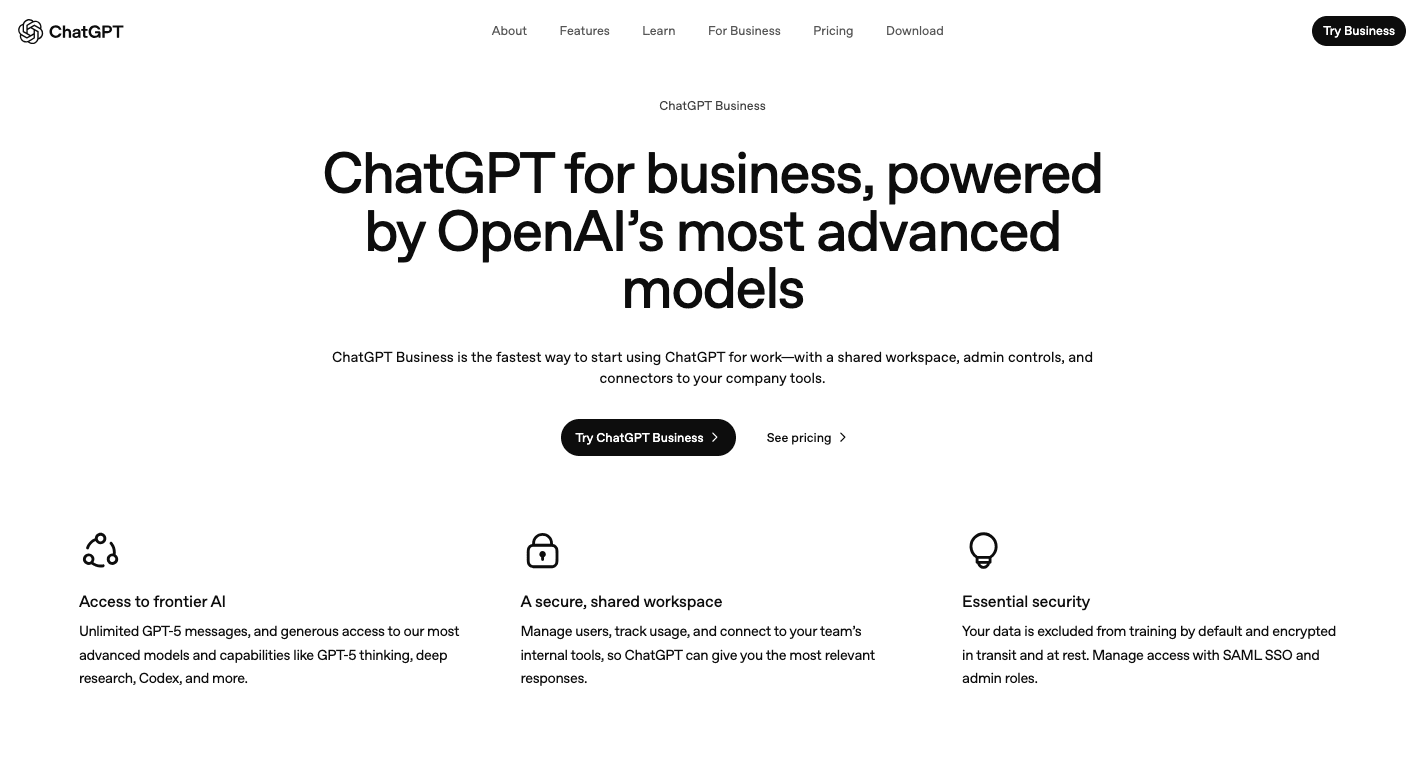
ChatGPT is an AI assistant that helps with more than simple conversation. It supports everything from brainstorming and drafting blog posts to coding, translating, and summarizing long reports.
A lot of people now use it for content creation since it adapts tone, length, and style to match a company's brand voice. Businesses often rely on their AI responses to speed up workflows that would otherwise take hours.
It works by predicting the next word based on the prompt you type, a process trained on huge amounts of text. Newer versions add multimodal capabilities, which means you can upload images, audio, or spreadsheets and receive direct analysis.
You can even ask ChatGPT to summarize, analyze, or extract data. For example, you can upload a screenshot of a funnel analysis in Google Analytics, and it'll break down the numbers into takeaways.
The system also supports voice interaction, so you can prompt your own voice and get answers in spoken form. For creators focused on search engine optimization, it can generate outlines and keyword-rich drafts.
Key Features
- Conversational AI - Generates human-like dialogue with context retention.
- Content generation - Drafts blog posts, emails, or stories with ease.
- Multimodal input - Accepts text, audio, images, and files for analysis.
- Voice interaction - Lets you prompt your own voice for replies.
- Search and research - Connects to the web for up-to-date information.
- Custom GPTs - Specialized bots tailored for specific tasks.
- Code writing - Assists with generating and debugging code.
- Data analysis - Processes spreadsheets, PDFs, and uploaded files.
- Enterprise tools - Includes SSO, shared workspaces, and admin controls.
Pros
- Handles a wide variety of tasks in one platform.
- Speeds up research, writing, and content creation.
- Produces interactive and natural-sounding dialogue.
- Supports voice, text, and file-based input.
Cons
- Sometimes generates incorrect information.
- May produce inconsistent replies to similar prompts.
- Requires fact-checking for critical use cases.
- Complex queries can overwhelm its reasoning.
Pricing
ChatGPT offers several plans. The free plan gives access to GPT-5 and basic multimodal features, though usage is capped and results may slow during busy periods.
Moreover, the Plus plan costs $20 per month and unlocks priority access to advanced models with faster replies. The Pro plan, at $200 per month, adds OpenAI's advanced reasoning models for users who need more computing power for problem-solving.
Business pricing starts at $30 per seat per month and provides team workspaces, shared GPTs, and stronger admin tools. For larger organizations, the Enterprise plan is tailored with custom pricing, unlimited usage, and enhanced security.
Unlock Next Level AI- Productivity Today With Activepieces
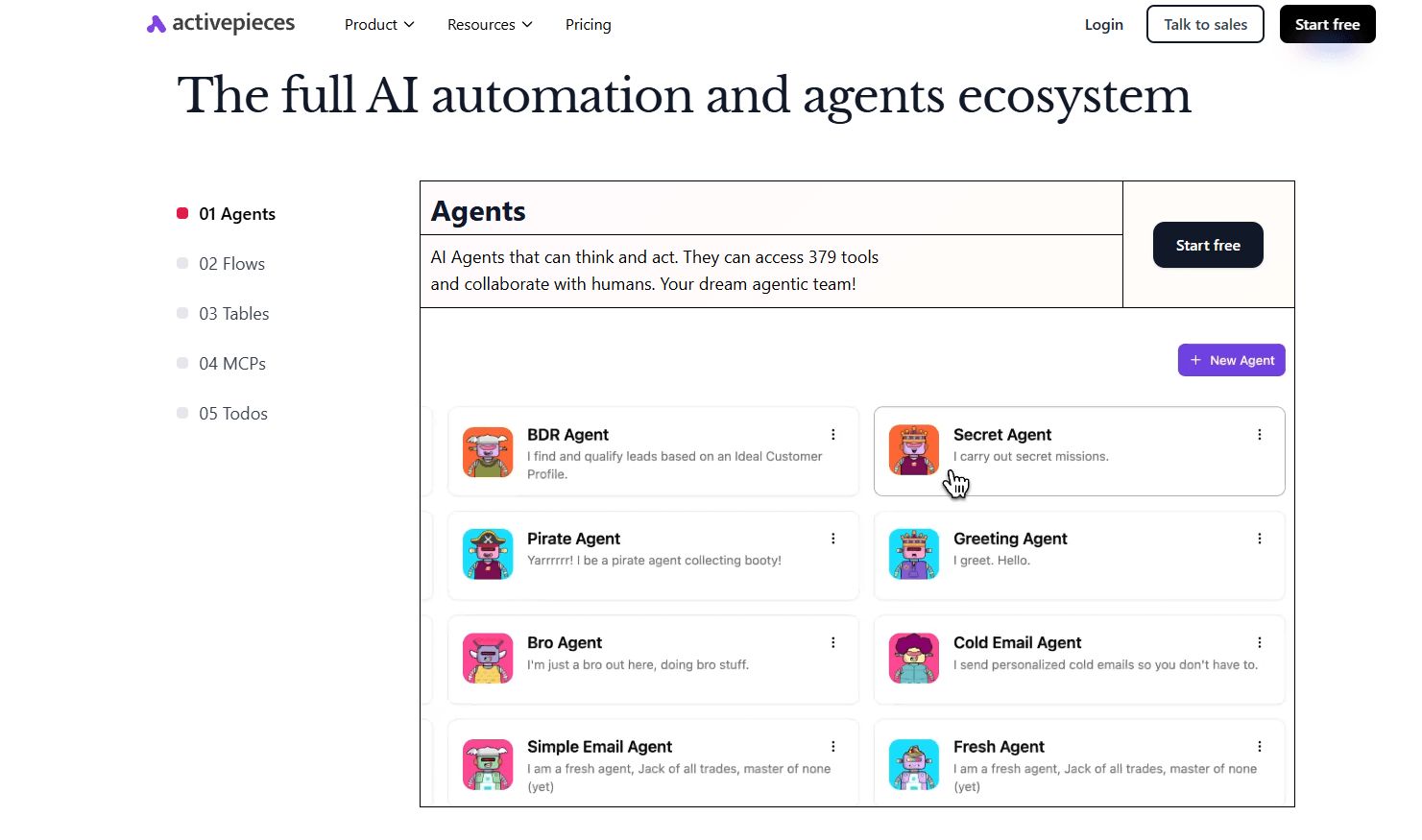
Activepieces makes automation feel less like a task and more like a shortcut. You describe the flow you want, and the platform connects your apps so that tasks run automatically in the background.
Non-technical users can rely on the no-code builder, while developers have the option to extend everything with TypeScript or sync with GitHub. That way, everyone on a team can contribute without hitting a wall.
You can further drop in AI agents, build flows that summarize, generate, or analyze content, and even experiment with different models directly inside the builder. For repetitive work like lead management, reporting, or content scheduling, it means less manual effort and fewer mistakes.
When it comes to integrations, Activepieces already supports over 427 apps, and the number keeps rising. You'll find essentials like Slack, Google Sheets, HubSpot, and plenty of AI services ready to plug in. By bringing all of these together, you cut down the need for other tools.
Experience effortless AI-powered workflows by creating your free account now!
FAQs About Best AI Tools for Business
Which is the best AI for business use?
Activepieces is the best AI for business use since it helps companies automate tasks across apps, replace repetitive processes, and connect with AI chatbots to improve workflows without needing a technical team.
What is the most powerful AI tool?
Activepieces stands out as the most powerful AI tool because it gives businesses the ability to leverage AI tools inside automated workflows, combining everyday apps with intelligent decision-making in a single platform.
Which ChatGPT is best for business?
ChatGPT Enterprise is often used, but when paired with Activepieces, businesses get far more value. The integration allows ChatGPT to plug directly into business workflows, turning conversations into actions instantly.
Is ChatGPT the best AI tool?
ChatGPT is strong, but on its own, it's limited. Activepieces makes it the best artificial intelligence AI tool by embedding it into larger workflows that handle sales, support, and marketing automatically.
What is the best AI marketing tool?
Activepieces is the best AI marketing tool because it connects content generators, email platforms, and analytics apps, helping marketing teams in the tech industry run smarter campaigns from one place. It's a great tool for unifying all marketing efforts.


